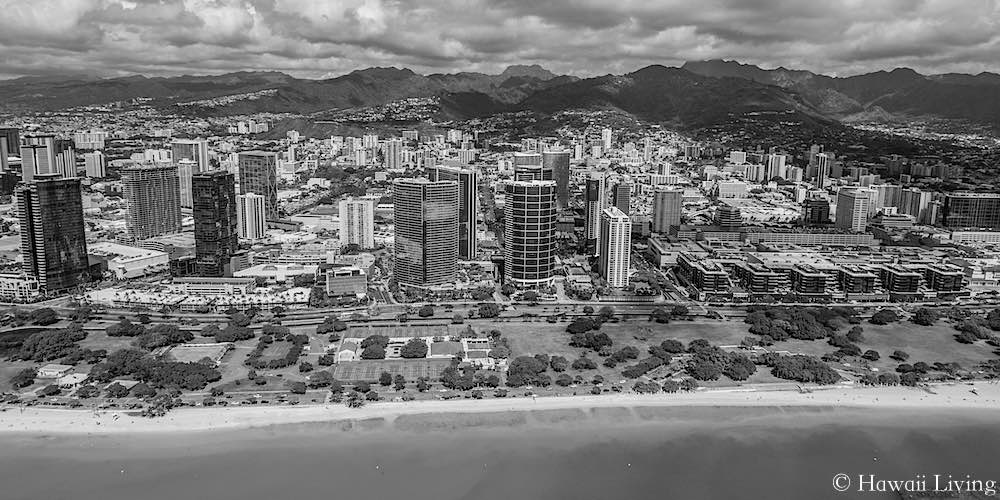The history of Honolulu’s condo neighborhoods is much more than the tale of paving and steel beams. There are rich stories behind each, that tell Hawaii’s story as well as the rich lives of the peoples who made their home there as well as the life of the land itself, as you’ll see.
We trace the sometimes astonishing evolution of the 4 preeminent condo neighborhoods in Honolulu today – Kakaako, Diamond Head’s Gold Coast, Waikiki and Ala Moana. You’ll learn how one has always held a status of importance and a domain of the elite, while the high status the rest enjoy today is something Islanders of old would find impossible, even laughable. You have to read it to believe it and we’ve got the story for you right here.
KAKAAKO
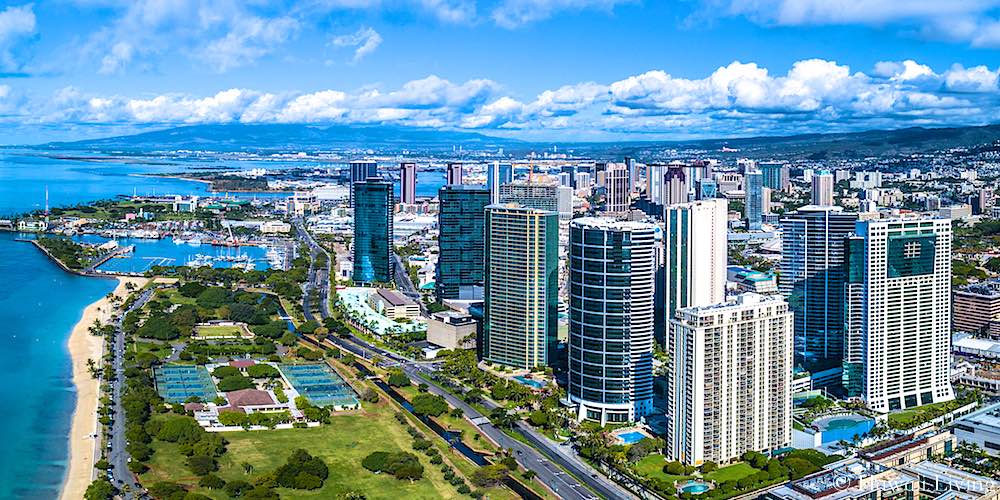
The new Kakaako neighborhood is undeniably a product of 21st Century innovation and planning, but it also a returning of these lands to its roots. Most have known this area of Honolulu as an industrial and commercial sector for their entire lives, but that has only been true for a relatively short time.
The increasingly busier urban streets was once the site of salt and fish ponds that sustained the Native Hawaiians who lived here. The ocean lapping up to the shore nearby also attracted fishermen who liked the easy commute.
In the 1800’s it grew and diversified, with Kamehameha I himself having a home here, as well as the emergence of Honolulu’s nearby port initially bringing Americans, Europeans and Chinese into the community, with successive ethnic waves, especially the Japanese, represented as time went by.
Businesses sprang up in the mid-19th Century to serve the neighborhood as well as all of Honolulu, with warehouses first appearing at this time. Still, this was a residential area, through and through, Kakaako homes characterized mainly by small houses and tenements.
For a century on from the 1850’s this became a place where blue-collar locals lived, with some parts classified as among the poorest in the city proper. The lower cost of housing was attractive as well as the nearby employment sources of the port and Downtown. It was a rich mix of hard-working families, still remembered as the most close-knit and generous of neighbors, and those who lived on the outskirts of the law.
By the 1940s the declining state of the housing still remaining, and the idea of giving the growing business sector an outlet to expand, caused the zoning being changed to Commercial, opening the door to the industrial concerns and warehouses that moved in, with very few homes left by the mid-1970s.
Kakaako’s Renewal is Set in Motion
Yet, it was at this precise moment of residential extinction in 1976 that the State Legislature claimed authority over this district from the city and created the Hawaii Community Development Authority (HCDA). Their mission was to oversee a potential revival and redevelopment of Kakaako. As we know, that didn’t happen overnight.
Over 3 decades later we’re now finally seeing the results, with the Ward Village (Howard Hughes) and Our Kakaako (Kamehameha Schools) projects fully rolling today. Their mandate is nothing short of a complete overhaul of the area bridging Downtown and Ala Moana.
The biggest story in Honolulu real estate is the reemergence of this region as a real neighborhood, but unlike anything previously imagined. A planned vision of future-centric living combined with the eternal pleasures of green spaces, ocean views, walkable environments along with vibrant, urban level shopping and dining options is coming into focus.
Some of the planned 20+ Kakaako condos are springing up, some already completed like Anaha, Waiea and The Collection. These residences are synonymous with terms like luxurious, cutting-edge and innovation, creating a category in Honolulu real estate that didn’t exist before.
From the mesmerizing creativity of their architecture, that never violate Hawaii’s singular environment, to the surrounding abundance of leisure choices easily available within strolling distance, all of it contained in an urban ambience that breathes freely with its open avenues and green spaces, you know this is someplace not only very special, but completely and utterly new. Welcome to the Future.
DIAMOND HEAD – THE GOLD COAST
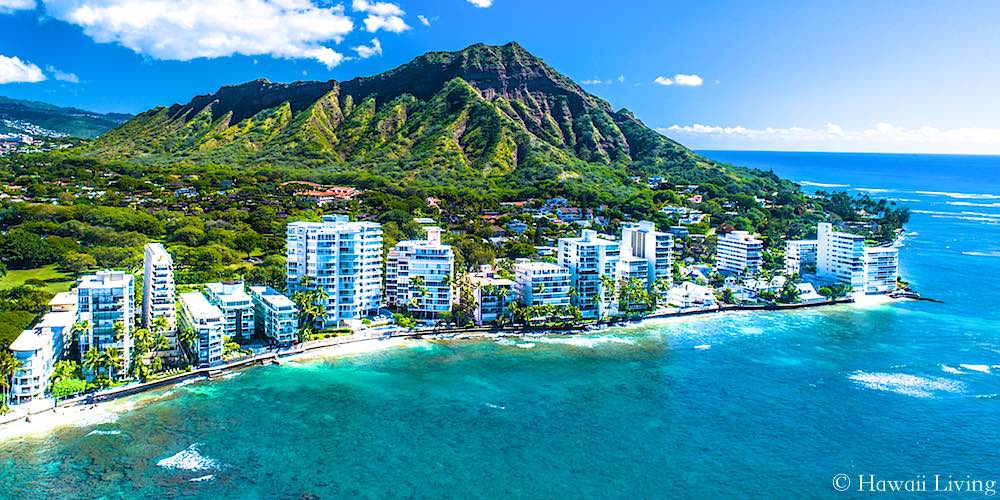
The Gold Coast area of Diamond Head has been a place for the elite of one kind or another. Today’s La Pietra School was previously the storied estate of the powerful Dillingham family and before that the site of a highly venerated heiau. There the Kings of Oahu, and finally Kamehameha I himself, made offerings to the gods, a practice vital to their power.
The Castle family had an equally famous mansion here that stood not just by the ocean, but partially over it. You could stand on the back lanai and drop your fishing line into the water directly below you. No casting needed.
Soon, the famous Gold Coast condos would replicate something very close to this experience, creating an exceptional lifestyle that cannot and will not ever be duplicated – by law.
This piece of coastline remained until the middle of the 20th Century the site of a few showpiece mansions owned by the rich and powerful along with the small enclave consisting of the last block of Kalakaua Avenue on Kahala side, Kiele Avenue just mauka of that and the corresponding stretch of Diamond Head Rd.
That collection of houses were smaller, but architecturally significant, created by some of Hawaii’s premier architects during the 1920s to 40s, and in a beguiling variety of styles. Most are still there, a visual feast to enjoy freely.
Honolulu Condos Like No Others
The Gold Coast condos followed in the 1950’s, taking up most of the oceanfront property – and ‘oceanfront’ has rarely been so perfect a term to describe a piece of real estate. These residences were all in place by the early 1960’s, a time when development had begun to rapidly accelerate, but regulations hadn’t completely kept pace.
That allowed these structures to be placed right up to the water’s edge, just before new laws closed the door on that ever happening again. There’s no grandfather clause here, either. When these buildings go, their replacements must follow the same, stricter construction guidelines as any new project.
It is this singular experience of hearing the waves wash up mere feet from your lanai or even feeling a little spray if the surf is particularly energetic that draws the clamor of bidding wars each time a Gold Coast condo unit goes on the market. It is the height of the Hawaii homeowner experience in many ways.
Very little construction has been added since that time over 50 years ago, freezing this neighborhood in a more elegant era of Honolulu. A reminder of what it was to live in those less hectic times that remains with us still.
WAIKIKI
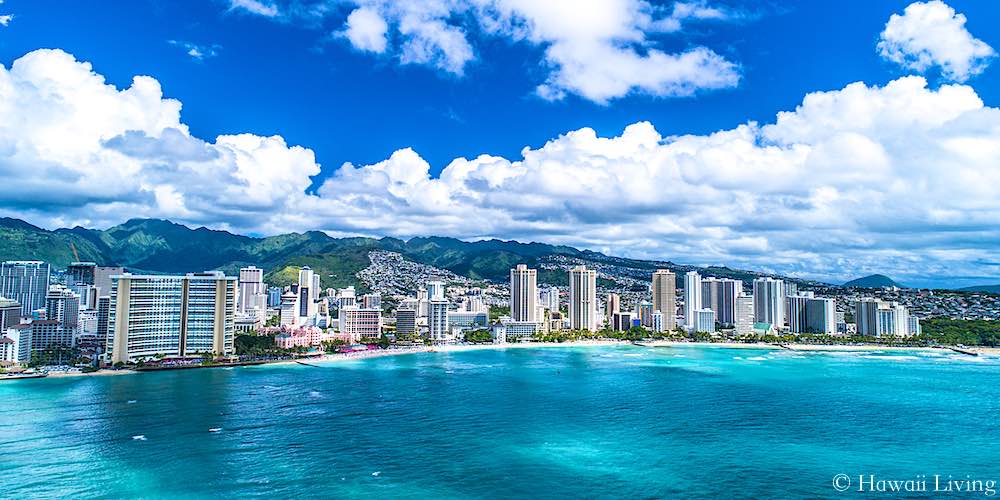
The neighborhood that has created the iconic image of tropical paradise was once something very different. In short, it was swampland. The Hawaiians understood that these conditions offered agricultural advantages, fully harnessing then with the introduction of an irrigation system sometime in the 1400’s.
With this innovation taro farming flourished here, along with fish ponds that were a substantial source of their diet. During the next few centuries Waikiki was the tropical version of a bread basket, serving the most essential needs of a community.
An important turn that foreshadowed the district’s future came with Kamehameha I’s unification of the Islands. Spending much of his time now on Oahu meant finding places to wind down from the stresses of ruling and one of his most frequented destinations for this became the shoreline of Waikiki.
Kamehameha’s successors followed his lead, eventually establishing large, permanent homes along the ocean. King Kalakaua, Princess Kai’ulani and Queen Liliuokalani all had sprawling residences here that bespoke the importance of their owners and the locale.
The building of a racehorse track in today’s Kapiolani Park by Kalakaua marked a further shift, making Waikiki into a major social & recreational center for the upper class. No longer was it just a place of retreat or where sometimes raucous parties could be held with a guarantee of privacy. It had become THE playground of Hawaii.
While that status continued and grew, the taro fields and fish ponds remained, though being partly replaced by rice farms by the turn of the Century. Farming went on in the mauka areas more or less undisturbed until the closing years of the 1920’s.
At that time the expanding economic importance of tourism became paramount and firm real estate was required to construct needed hotels and attractions upon.
A World Famous Resort Emerges – Literally
That was solved by the digging of Ala Wai Canal, making solid ground out of the swampland forever. The newly emerged property was quickly divided into lots and sold off. Modern Waikiki was born.
The following 30 years or so saw much of the lots filled in with homes and business, but little, if anything, beyond the low-rise limit of 5 floors. With tourists arriving mainly by boat in that era, arrival numbers could only go so high. There was no need for anything more substantial.
Statehood and the arrival of the jet age would sweep those limits away, bringing almost overwhelming population growth and equally booming tourism numbers. Accommodations were need for both and the only place to build it was up. Waikiki condos were the obvious solution to a pressing problem.
With hotels and tourist spots taking most of the makai areas, it was clear that the mauka sections would provide the pressure valve for residences. This most famously was seen on the streets between Kuhio Avenue and the Ala Wai.
A once thriving neighborhood on those lots had taken a downturn by the 1960’s, the houses falling into various states of disrepair from neglect and owners who either lacked the money, the motivation, or both, to keep them up. Some parts of the area had declined so much that they were best avoided due to activity that went on there.
The Waikiki Condos Take Over
The government saw an opportunity to both solve the issue of the blight on these streets as well as provide the housing that was badly needed. Much of the problem areas were condemned, opening the way for a forest of construction cranes that quickly rose up.
By the late 1970’s almost all of ‘The Jungle’, as it had been known, had disappeared, high-rise residences in their place. In Waikiki, condos were now the standard living choice, changing the face of this district. Some certainly regretted the end of the single family homes and the closer knit neighborhood of old, but it was a necessary change, providing needed inventory for an almost bottomless demand.
That same blueprint of high-rises is being followed still today, with places like Trump and the Ritz-Carlton providing a distinctly more upscale side that had been absent previously, and a few more are still to come, including one that will eventually stand on the site of King’s Village.
Waikiki condominiums look to be entering a new era of higher levels of living, which come with an equal rise in pricing. While it will take a lot of changes before the entire place becomes exclusively luxury properties, it’s no secret that this is a place of elevated home values and price tags, even for Hawaii – and that’s one thing that hasn’t changed and probably never will.
ALA MOANA
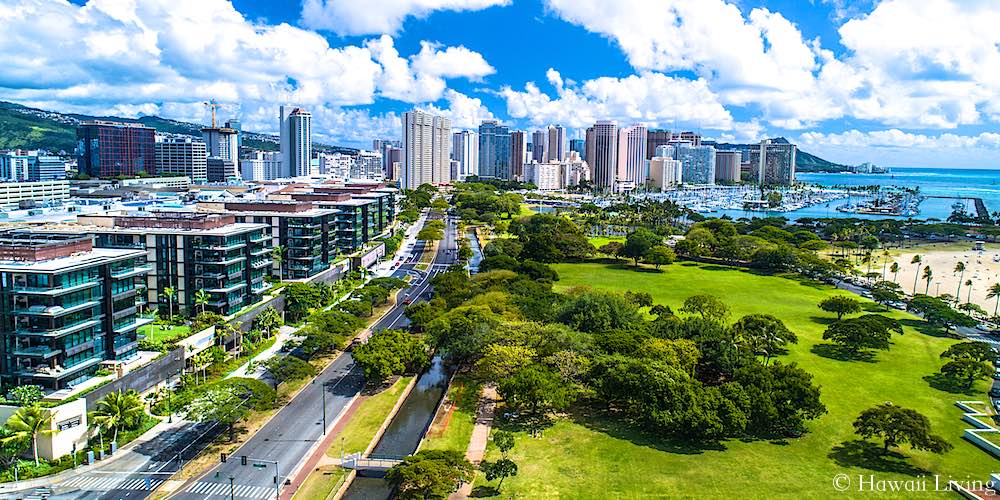
The Pre-20th Century Ala Moana area shared the same terrain as neighboring Waikiki’s mauka swampland. For most of this district’s existence the shoreline here was actually near the makai edge of where Ala Moana Blvd runs. From there on it was mainly wetlands, ending only when it reached what would later be King Street’s path through this part of Honolulu.
It should be no surprise, then, that this real estate was utilized for taro farms and the fish ponds that provided a solid portion of the Native Hawaiian diet. This would remain the main function of the district until the 1930’s, when it underwent a transformation even greater than the Ala Wai’s creation, which happened at almost the same time.
Local civic and advocacy groups, such as the Outdoor Circle, had pushed for more parks to be built in Honolulu for some time before this. It was Ala Moana’s proximity to Waikiki’s growing tourism business that made it a prime candidate for such a project.
Fortuitously, the U.S. government’s public works programs in the early years of the Great Depression provided much of the labor and funding to do it. With the Ala Wai nearing completion, the dredging crews just moved a short distance west and got to work.
Ultimately the dredging of Kewalo Basin resulted in a sweeping alteration to this coastline. It is due to this project that we now have: the Ala Wai’s outlet to the ocean; the boat harbor; a new shoreline 200 to 300 yards makai of the old one; Ala Moana beach & lagoon; plus a stunning 76 acre green park where solid reef and the Pacific itself once claimed domain.
No longer a sleepy, marsh-filled landscape you only drove through on the way to or from Waikiki, this was a huge step toward the viable and thriving community it was to become shortly. From that immense project came further work that drained the wetlands, allowing small single family home neighborhoods to arise in the mauka sections.
The 2nd Puzzle Piece Completes Ala Moana
Nothing could prepare anyone, however, for the seismic impact that resulted as dredging teams returned in 1957 to fill in the empty wetlands just across the road from Ala Moana Park.
The effects of the Ala Moana Center’s opening in 1959 cannot be overstated. Almost immediately it ended Downtown’s unchallenged reign as the city’s retail center forever. It also made this part of Honolulu not just an economic and employment power, but also a surging neighborhood.
Development began in earnest in the 1960’s, with towering Ala Moana condos going up especially during the succeeding decade, all of them clustered near the site of the mall. Some of the most impressive were the Yacht Harbor Towers (1973), 40 floors of ocean views right on the Ala Moana/Waikiki border, and the Uraku Tower (1989), a product of the Japanese boom and made as a super-luxury condominium that is still desirable 30 years later. The two decades preceding the Millennium saw the build-up more or less end. At that point there was little space left to build on.
Construction has begun to come to life again in recent years. The new level of lifestyles that are being catered to is unmistakable with the Ala Moana Center itself spawning residences on site. First the luxury of One Ala Moana and now the even more upmarket Park Lane has taken over the makai side of the complex. Their opulent amenities and widescreen views over the park and ocean have fully justified the fanfare they’ve gotten from the moment the projects were announced.
HONOLULU CONDOS – MORE THAN A MORTGAGE
The history of each of these Honolulu condo neighborhoods is a fascinating one, but all reflect the story of the Islands. Especially the rocketing events of the last century or so. Still, they all stand out uniquely in their own rights and their own ways, just as they did so long ago.
That’s important as you when you buy a home, but especially in Hawaii, you purchase not just a structure, but also the spirit of that particular place. Keep that in mind as you seek your part of Hawaii. May you find the spirit that is the right match for yours.
